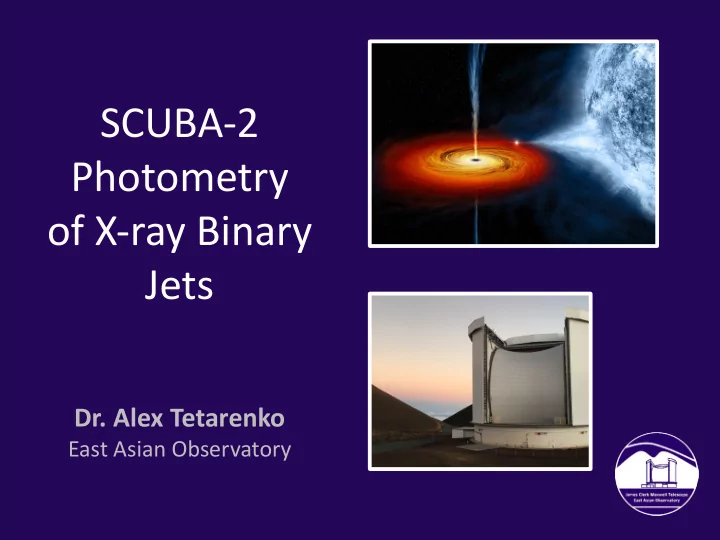

SCUBA-2 Photometry of X-ray Binary Jets Dr. Alex Tetarenko East Asian Observatory
Relativistic Jets Launched From Black Holes Credit: J. Miller-Jones 6 kpc 6 pc 18 AU Radio galaxy Cygnus X-1 Cen A Credit: Gallo et al. 2005 Credit: NRAO Alex Tetarenko – UH Labs
Black Hole X-ray Binaries • Black hole accreting matter from a companion star • Rapidly evolve through bright outburst periods on timescales of days to months • Emit across the electromagnetic spectrum Alex Tetarenko – UH Labs
Outburst and Jet Behaviour Intermediate High State States (>0.5 L edd ) (~ 0.3 L edd ) Soft Compact Jet State Hard State (<0.1 L edd ) Hardness Jet Ejecta Alex Tetarenko – UH Labs
Hard State Compact Jets Spectral Optically Thick Flux Break Density Optically Thin Sub-mm Frequency
Broad-band Spectrum • Originates from superposition of many synchrotron components along jet axis • Jet properties encoded within exact spectral shape • Key observables: spectral indices, location of spectral break Alex Tetarenko – UH Labs
Jet Spectral Breaks • Location evolves as accretion properties change during outburst • Evolution contrary to simple jet models • Correlates with X-ray photon index Alex Tetarenko – UH Labs
Jet Spectral Breaks • Location evolves as accretion properties change during outburst • Evolution contrary to simple jet models • Correlates with X-ray photon index Alex Tetarenko – UH Labs
Relativistic Jet Simulations • Broad-band observations needed to test and guide simulations • Tie jet dynamics, plasma conditions to the jet spectral break New solutions in agreement with observed spectral break evolution! Alex Tetarenko – UH Labs
(Sub)-Millimetre Frequencies • Fill 2 order of magnitude ALMA gap in broad-band spectrum JCMT • Uniquely probe jet emission close to compact object NOEMA • Need rapid response ToOs to obtain data of X-ray binaries. SMA Alex Tetarenko – UH Labs
Target Source: V404 Cygni • Prolonged P orb = 6.5 days quiescent period of 26 yrs. d=2.39 +/- 0.14 kpc K0 • Well determined sub-giant system parameters M BH = 7.15 +/- 0.35 M ¤ • Low optical extinction i=60-80 degrees E(B-V)=0.1 Credit: R. Hynes • Parallax distance Alex Tetarenko – UH Labs
Lab Procedure • Reduce a JCMT SCUBA-2 observation of V404 Cygni during the decay of its 2015 outburst. • Combine your SCUBA-2 sub-mm measurement with other simultaneous multi- wavelength data to build a broad-band spectrum. • Fit different emission models to your spectrum to deduce jet properties. Alex Tetarenko – UH Labs
Additional Notes • Follow the detailed procedure in the lab writeup for reducing your data. • You will NEED to FIRST download the data! • You will NEED to have the Starlink software installed on your machine. • This lab involves some coding, don’t freak out if you haven’t done any coding before! • All coding and analysis should be done in the jupyter notebook provided. Alex Tetarenko – UH Labs
What do you need to hand in? • Please email me your lab writeup and jupyter notebook • Please use the subject line: UH Labs XRB Spectrum – [NAME] • My email is: a.tetarenko@eaobservatory.org • Questions? – Email me! Thanks! Alex Tetarenko – UH Labs
Recommend
More recommend